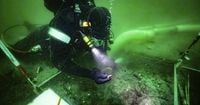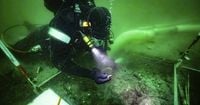Beneath the tranquil blue waters of Denmark’s Bay of Aarhus, a remarkable window into humanity’s distant past has been pried open. Archaeologists have uncovered the submerged remains of a Stone Age settlement, lost to the encroaching sea more than 8,500 years ago. This discovery, hailed as a Stone Age "Atlantis" by some, is not just a feat of underwater archaeology—it’s a testament to the resilience and adaptability of ancient coastal communities, and a poignant reminder of how rising seas have shaped, and continue to shape, human history.
This summer, a team of divers descended roughly eight meters (26 feet) below the surface near Aarhus, Denmark’s second-largest city. There, they meticulously excavated an area of about 40 square meters (430 square feet) of seabed, using specialized underwater vacuum technology to gently extract artifacts from the silt. According to Greek Reporter and Daily Mail, their finds included animal bones, stone tools, arrowheads, a seal tooth, and a small piece of worked wood believed to be a simple tool—each piece offering a rare, tangible connection to the people who once called this now-drowned coast home.
The project behind this discovery is nothing short of ambitious. Funded by the European Union to the tune of €13.2 million ($15.5 million), it is a six-year international research initiative linking experts from Aarhus University, the University of Bradford in the United Kingdom, and Germany’s Lower Saxony Institute for Historical Coastal Research. Their mission? To map submerged landscapes in the Baltic and North Seas, uncover lost Mesolithic settlements, and better understand how prehistoric societies responded to dramatic environmental change—especially as modern offshore wind farms and sea infrastructure projects expand into these waters.
Most Stone Age discoveries in Denmark have previously been made far inland, well away from the shifting coastlines of the past. This new site, however, provides an unprecedented glimpse into life on the ancient shoreline. "Here, we actually have an old coastline," said Peter Moe Astrup, the underwater archaeologist leading the Danish excavations, as quoted by Greek Reporter. "We have a settlement that was positioned directly at the coastline. What we actually try to find out here is how was life at a coastal settlement."
Reconstructing that life is no simple task. After the last Ice Age, as massive glaciers melted, global sea levels surged upward. Around 8,500 years ago, the waters rose at a staggering rate—about two meters (6.5 feet) per century, according to Astrup. This relentless advance forced hunter-gatherer groups further inland, submerging the homes and livelihoods of entire communities. The Bay of Aarhus site, preserved beneath layers of sediment, acts as what Astrup calls "a time capsule." When the sea inundated the area, it sealed organic material in an oxygen-free environment, halting the decay that would have otherwise erased these traces from history. As Astrup put it, "We find completely well-preserved wood. We find hazelnut. … Everything is well preserved."
The excavation process is painstaking. Divers comb the seabed meter by meter, searching not only for the stone tools and bones that typically survive the millennia, but also for elusive organic remains—hazelnuts, worked wood, perhaps even remnants of fishing structures or harpoons. Each find is carefully documented, helping researchers reconstruct the layout and daily rhythms of the settlement. The hope, as Astrup and his team have stated, is to uncover further evidence of how these ancient people fished, hunted, and gathered along the shifting edge of land and sea.
One of the project’s more innovative techniques is dendrochronology, or tree-ring dating. By analyzing submerged tree stumps preserved in the mud, scientists can determine precisely when ancient coastal forests were drowned by the rising tides. Jonas Ogdal Jensen, a dendrochronologist at the Moesgaard Museum, explained to Daily Mail, "We can say very precisely when these trees died at the coastlines. That tells us something about how the sea level changed through time." This data not only helps date the settlement itself, but also paints a broader picture of the environmental upheaval that forced dramatic changes in human settlement patterns.
The significance of the Bay of Aarhus site extends far beyond its immediate archaeological riches. For one, it offers a rare glimpse into the lives of Mesolithic people who lived directly on the coast—a context that has been largely missing from previous finds, which were typically located further inland. The preservation of organic materials such as wood and nuts allows researchers to understand not just what people made and ate, but also how they adapted their tools and techniques to survive in a changing world. As reported by Greek Reporter, living directly on the coastline meant relying heavily on fishing, hunting seals, and gathering plants from nearby forests—an existence intimately tied to the rhythms and dangers of the sea.
The discovery is also part of a much broader effort to map the submerged prehistory of Northern Europe. Later phases of the project will target two sites in the more challenging waters of the North Sea, including the legendary Doggerland—a vast landmass that once connected Britain to continental Europe before it too was swallowed by the waves. The hope is that, by piecing together these underwater landscapes, scientists can better understand how prehistoric societies responded to environmental crises—and perhaps glean lessons for our own era of rising seas.
It’s a timely reminder. Global sea levels rose by an average of 4.3 centimeters (1.7 inches) in the decade up to 2023, a trend driven by ongoing climate change. For the scientists working in Denmark, the submerged Stone Age settlement is more than just a relic of the past—it’s a warning and an inspiration. "It’s hard to answer exactly what it meant to people," Astrup reflected. "But it clearly had a huge impact in the long run because it completely changed the landscape."
Recent years have seen Denmark yield other archaeological treasures as well, from a 1,400-year-old royal ring to the oldest runic writing ever found in the country. Yet few discoveries capture the imagination quite like this "time capsule" beneath the Bay of Aarhus, where the echoes of ancient lives still linger in the silt.
As the divers continue their work—meter by meter, artifact by artifact—the story of Denmark’s Stone Age coast grows ever richer. In these submerged ruins, we glimpse not only the challenges of a vanished world, but also the enduring human capacity to adapt, survive, and leave traces for future generations to find.


